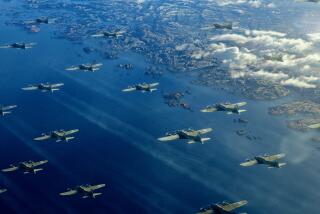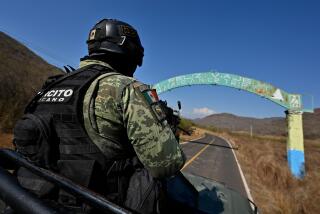Demolition Experts : Marine Team Feels Safe in Dangerous Job
- Share via
CAMP PENDLETON — With the leisurely gait of a gentleman out for a Sunday stroll, Staff Sgt. Paul Spencer made his way across terrain most sane men would avoid, an artillery range known as the Zulu impact area.
Striding up a grassy hillside pockmarked with craters as wide as automobiles and littered with fragments of howitzer shells, Spencer carefully surveyed the ground. Then he spotted it--an undetonated, high-explosive mortar half-buried in the crusty sod.
Hunkering down next to the shell, Spencer loosened the earth with a large knife and plucked the deadly device from its resting spot with the ease of a gardener uprooting a carrot.
No problem. All in a day’s work for the troops of Camp Pendleton’s bomb squad, the Explosive Ordnance Disposal team.
The more than two dozen members of the elite, all-volunteer unit tread on a regular basis into the treacherous target ranges set amid the rolling chaparral on this sprawling Marine Corps base.
Their task, among the most dangerous assignments in the peacetime armed forces, is to clear the terrain of unexploded ordnance, everything from 20-millimeter rounds shot from a Cobra helicopter to lumbering, 500-pound bombs dropped by attack jets.
Although that daily mission may seem just short of suicidal to most civilians, these bomb-disposal experts insist the job is anything but hazardous. Like archeologists of artillery, they use a library of knowledge on the characteristics of the explosives to time and again render them harmless.
“Knowledge is the key in this business,” said Chief Warrant Officer Jim Tadlock, a bomb-disposal expert for 10 years. “If you know what you’re dealing with, you’ve got it licked.”
Spencer agreed, saying he thinks the work “is probably safer than driving down Interstate 5.”
Still, as the 27-year-old Marine knows all too well, accidents occasionally do happen.
In 1983, Spencer was stationed in Okinawa, Japan. One day, he was out on a wind-swept hilltop, disposing of several pounds of old propellant powder typically used in large, 105-millimeter projectiles. Normally, the stuff is dumped on the ground and ignited, but the breezes were whipping that day so Spencer poured the propellant into a metal container.
Suddenly, static electricity in the air ignited the powder, sending a fireball billowing upward into Spencer’s chest. For two weeks, the young Marine lay flat on his back, his eyes welded shut, burns covering 40% of his body.
After a month in the hospital he was released, returning to duty a short time later.
“The first thing I did when I was able to get back on the horse was go out and burn 600 pounds of black powder,” Spencer said.
Such incidents are relatively rare, military officials say. No bomb-disposal technician has been injured at Camp Pendleton since 1977, when a Marine suffered shrapnel wounds when a grenade exploded during a sweep of a firing range.
Throughout the Corps, 24 Marines have died while engaged in bomb-disposal duties since the end of World War II. Marine officials say that is a commendable record considering the tens of thousands of explosive devices that have been handled.
The main reason for that safety record is training. Each of the Marine Corps’ current crop of more than 175 bomb-disposal experts has spent six months learning the secrets of the trade at the military’s Basic Ordnance Disposal School in Indian Head, Md. In addition, the technicians are required every three years to take a two-week refresher course, boning up on the latest techniques and new types of ordnance.
With literally thousands of varieties of bombs, mortars, grenades and explosive devices employed by the world’s military forces, it is not an easy education.
The bomb-disposal technicians of today are far better prepared than the field’s pioneers, who approached a bomb with only a fraction of the know-how. Indeed, much of the knowledge grew from trial and error.
The British originated the first formalized bomb squad during World War II, when the Germans were showering London and other cities with high-explosive devices during the blitzkrieg. America entered the field in 1943, when a team was dispatched to England to study the techniques being used for ordnance disposal.
After the war, the United States founded a training school, attempting for the first time to teach the art of bomb disposal in a classroom. Even as the discipline grew increasingly sophisticated, many bomb-disposal technicians were maimed or killed in those early years while probing the intricacies of enemy ordnance on the battlefield.
“A lot of good men died the hard way, learning the tricks of this business,” Tadlock said. “If not for them, we wouldn’t be where we are today.”
Perhaps the greatest leap in technology came during the early 1950s, as bomb-disposal teams handled ordnance during the Korean War, experts say. Despite such strides, about a half-dozen technicians still paid a price for their dangerous occupation in the Vietnam War, dying while handling enemy explosives, according to Master Gunnery Sgt. Howard Gould, a 25-year veteran of the squad.
Modern practices dramatically limit fatal accidents on the bomb detail, Marine Corps brass say. During a recent expedition out into the desolate Zulu impact area, several members of the ordnance-disposal team displayed the knowledge that has been gleaned through the years.
Packed into pickups, the squad motored slowly into the back-country of the artillery range, winding a path between the rusty, battered shells of discarded amphibious vehicles and trucks commonly used as targets by tanks and artillery units.
Parking a few hundred feet from a target zone, team members began picking their way on foot through the shrapnel and fragments of
bombs. The job was to clear a path so other troops could safely cart in new targets. Eyes glued to the ground, the group searched for the tell-tale signs of unexploded ordnance lurking amid the golden ragweed.
Spotting the tail fins of a cucumber-shaped mortar round, Staff Sgt. Michael Reynolds stooped down and gingerly scooped earth away from the device. One look and Reynolds knew what he had--a highly explosive device that could easily blow up if jostled.
As is commonly done in such situations on the artillery range, Reynolds began preparing to detonate the mortar where it lay. First he meticulously stuck a block of plastic explosive to the device, then attached a 10-foot fuse. Ignited, the fuse burned slowly as the squad retreated to safety several hundred yards away.
The blast echoed through the craggy fingers of the valley, sending a thick cloud of dust into the sky. Mission accomplished, Reynolds looked satisfied.
“It’s a challenge,” Reynolds said later, puffing contently on a thin cigar. “I enjoy the danger that’s involved with this work, that type of adrenalin rush that’s involved with it.”
Indeed, like many of his peers, the 34-year-old Marine decided to become an ordnance-disposal expert because he was looking for a job free of the typical workaday tedium.
Before joining the bomb squad five years ago, Reynolds served as a drill instructor, teaching raw recruits the rudiments of military life. He believes his days spent with rookie Marines handling armaments were decidedly more dangerous than his present assignment handling mortars and other live ordnance.
Still, Reynolds concedes the job does have its risks.
“There’s still that little thing in the back of your mind wondering if what you’re handling is going to do something strange,” he said. “But I’d rather come out here and work and sweat and get dirty and blow things up than anything else. I hate paper work.”
Once a year, the entire Camp Pendleton team is joined by ordnance experts from the Marine Air Station at El Toro to conduct an extensive, two-week sweep of all the artillery ranges on the 196-square-mile base.
Starting at one end, the crew works its way on foot across the rugged terrain, setting plastic explosives on the live stuff that’s found and then quickly moving on. It’s tough work. “Blowin’ and goin’,” Tadlock calls it. To assure that no one gets hurt, 17-minute fuses are used. Still, there are occasional close calls.
Tadlock recalls one incident in particular. The 31-year-old Marine was clambering over an obstacle when a large blast went off a fair distance behind him. Just as the explosion occurred, Tadlock slipped and fell forward. It was lucky he did. Sprawled on the ground, the Marine heard a chunk of shrapnel buzz inches above his head and splatter into the earthen bank before him.
Not all the bomb-disposal team’s efforts are focused on the wide-open expanses of the artillery range. Sometimes, the squad is called in to handle more disturbing assignments.
A year ago, two young Marines went scavenging on one of the base’s artillery ranges, defying military regulations that prohibit any personnel from entering the dangerous impact zones. They returned to their post at the base armory with four high-explosive rockets. As the pair tinkered with one of the devices, it went off.
When three members of the bomb-disposal team arrived at the armory, a pool of blood had spread over the floor of the battered building. The body of one young Marine lay crumpled on the floor.
“We were met by the smell of the explosion mixed with the blood,” recalled Sgt. Doug Finn. “It’s something you don’t forget.”
While the bomb technicians prepared to tackle the three undetonated rockets, crews began sandbagging the structure and removing the armaments within. After 11 hours of tedious work, Finn and the others disarmed the explosives. For their efforts, the trio later received the Naval Commendation.
Finn concedes he’s had an occasional mishap. Once, the young Marine was disposing of smoke flares, piling up a bunch of the sticks and burning them. When Finn returned to check on the progress of the operation, one of the flares popped open, engulfing him in a cloud of red smoke.
Although unhurt, Finn was smudged with red. Concerned about suffering ridicule at the hands of his colleagues back at the team’s headquarters, Finn tried to wipe the stuff off his face. It didn’t work. When Finn returned, his buddies broke out laughing, ordering him to supply the squad with a case of beer, the typical restitution for a bonehead mistake.
With so much at stake each time they troop out on an assignment, an understandable feeling of fraternity develops among members of the ordnance-disposal team. Theirs is a risky endeavor, where heroes are measured not so much by their successes, but by their longevity.
“There’s an old saying we use around here,” Tadlock said. “It goes like this: There are old bomb technicians and there are bold bomb technicians, but there are no old, bold bomb technicians.”
More to Read
Sign up for Essential California
The most important California stories and recommendations in your inbox every morning.
You may occasionally receive promotional content from the Los Angeles Times.










